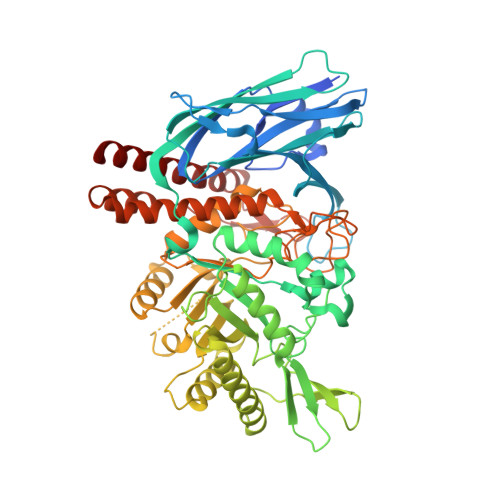The Details of Glycolipid Glycan Hydrolysis by the Structural Analysis of a Family 123 Glycoside Hydrolase from Clostridium Perfringens
Noach, I., Pluvinage, B., Laurie, C., Abe, K.T., Alteen, M., Vocadlo, D.J., Boraston, A.B.(2016) J Mol Biology 428: 3253
- PubMed: 27038508
- DOI: https://doi.org/10.1016/j.jmb.2016.03.020
- Primary Citation of Related Structures:
5FQE, 5FQF, 5FQG, 5FQH, 5FR0 - PubMed Abstract:
Clostridium perfringens is an opportunistic pathogen of humans and animals whose genome encodes a wide variety of putative carbohydrate-hydrolyzing enzymes that are increasingly being shown to be directed toward the cleavage of host glycans. Among these putative enzymes is a member of glycoside hydrolase family 123. Here we show that the recombinant enzyme (referred to as CpNga123) encoded by the gene cloned from C. perfringens strain ATCC 13124 (locus tag CPF_1473) is a β-N-acetylgalactosaminidase, similar to NgaP from Paenibacillus sp. TS12. Like NgaP, CpNga123 was able to cleave the terminal β-D-GalNAc-(1→4)-D-Gal and β-D-GalNAc-(1→3)-D-Gal motifs that would be found in glycosphigolipids. The X-ray crystal structure of CpNga123 revealed it to have an N-terminal β-sandwich domain and a (β/α)8-barrel catalytic domain with a C-terminal α-helical elaboration. The structures determined in complex with reaction products provide details of the -1 subsite architecture, catalytic residues, and a structural change in the active site that is likely required to enable hydrolysis of the glycosidic bond by promoting engagement of the substrate by the catalytic residues. The features of the active site support the likelihood of a substrate-assisted catalytic mechanism for this enzyme. The structures of an inactive mutant of CpNga123 in complex with intact GA2 and Gb4 glycosphingolipid motifs reveal insight into aglycon recognition and suggest that the kinked or pleated conformation of GA2 caused by the β-1,4-linkage between N-acetylgalactosamine and galactose, and the accommodation of this conformation by the enzyme active site, may be responsible for greater activity on GA2.
- Department of Biochemistry and Microbiology, University of Victoria, Victoria, British Columbia V8W 3P6, Canada.
Organizational Affiliation:


















